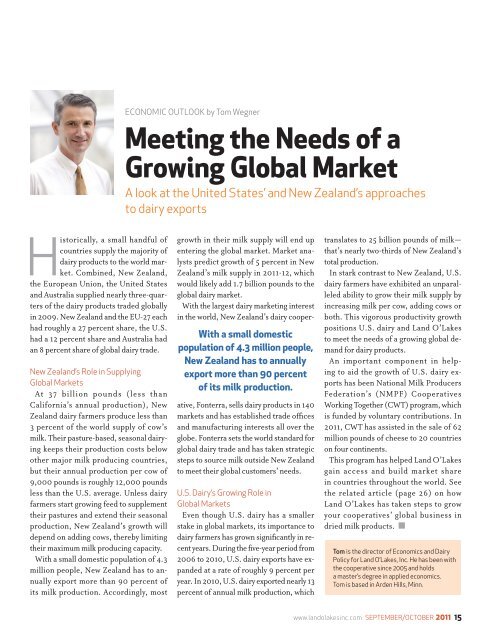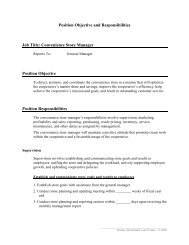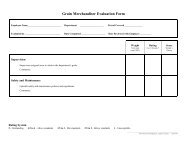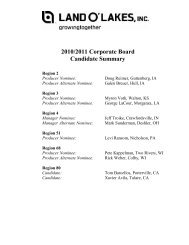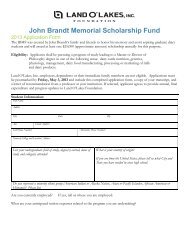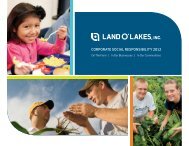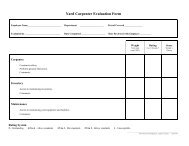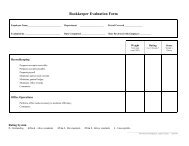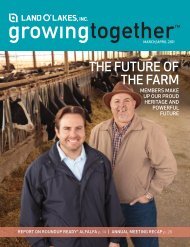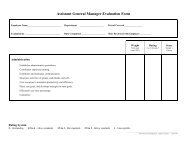2011 September/October Issue - Land O'Lakes Inc.
2011 September/October Issue - Land O'Lakes Inc.
2011 September/October Issue - Land O'Lakes Inc.
Create successful ePaper yourself
Turn your PDF publications into a flip-book with our unique Google optimized e-Paper software.
ECONOMIC OUTLOOK by Tom WegnerMeeting the Needs of aGrowing Global MarketA look at the United States’ and New Zealand’s approachesto dairy exportsHistorically, a small handful ofcountries supply the majority ofdairy products to the world market.Combined, New Zealand,the European Union, the United Statesand Australia supplied nearly three-quartersof the dairy products traded globallyin 2009. New Zealand and the EU-27 eachhad roughly a 27 percent share, the U.S.had a 12 percent share and Australia hadan 8 percent share of global dairy trade.New Zealand’s Role in SupplyingGlobal MarketsA t 3 7 b i l l i o n p o u n d s ( l e s s t h a nCalifornia’s annual production), NewZealand dairy farmers produce less than3 percent of the world supply of cow’smilk. Their pasture-based, seasonal dairyingkeeps their production costs belowother major milk producing countries,but their annual production per cow of9,000 pounds is roughly 12,000 poundsless than the U.S. average. Unless dairyfarmers start growing feed to supplementtheir pastures and extend their seasonalproduction, New Zealand’s growth willdepend on adding cows, thereby limitingtheir maximum milk producing capacity.With a small domestic population of 4.3million people, New Zealand has to annuallyexport more than 90 percent ofits milk production. Accordingly, mostWith a small domesticpopulation of 4.3 million people,New Zealand has to annuallyexport more than 90 percentof its milk production.growth in their milk supply will end upentering the global market. Market analystspredict growth of 5 percent in NewZealand’s milk supply in <strong>2011</strong>-12, whichwould likely add 1.7 billion pounds to theglobal dairy market.With the largest dairy marketing interestin the world, New Zealand’s dairy cooperative,Fonterra, sells dairy products in 140markets and has established trade offi cesand manufacturing interests all over theglobe. Fonterra sets the world standard forglobal dairy trade and has taken strategicsteps to source milk outside New Zealandto meet their global customers’ needs.U.S. Dairy’s Growing Role inGlobal MarketsEven though U.S. dairy has a smallerstake in global markets, its importance todairy farmers has grown significantly in recentyears. During the five-year period from2006 to 2010, U.S. dairy exports have expandedat a rate of roughly 9 percent peryear. In 2010, U.S. dairy exported nearly 13percent of annual milk production, whichtranslates to 25 billion pounds of milk—that’s nearly two-thirds of New Zealand’stotal production.In stark contrast to New Zealand, U.S.dairy farmers have exhibited an unparalleledability to grow their milk supply byincreasing milk per cow, adding cows orboth. This vigorous productivity growthpositions U.S. dairy and <strong>Land</strong> O’Lakesto meet the needs of a growing global demandfor dairy products.An important component in helpingto aid the growth of U.S. dairy exportshas been National Milk ProducersFederation’s (NMPF) CooperativesWorking Together (CWT) program, whichis funded by voluntary contributions. In<strong>2011</strong>, CWT has assisted in the sale of 62million pounds of cheese to 20 countrieson four continents.This program has helped <strong>Land</strong> O’Lakesgain access and build market sharein countries throughout the world. Seethe related article (page 26) on how<strong>Land</strong> O’Lakes has taken steps to growyour cooperatives’ global business indried milk products. !Tom is the director of Economics and DairyPolicy for <strong>Land</strong> O’Lakes, <strong>Inc</strong>. He has been withthe cooperative since 2005 and holdsa master’s degree in applied economics.Tom is based in Arden Hills, Minn.www.landolakesinc.com SEPTEMBER/OCTOBER <strong>2011</strong> 15


